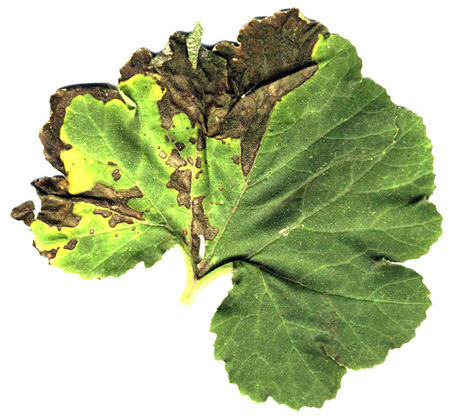Diseases
Xanthomonas campestris pv. cucurbitae (Bryan) Dye - Bacterial Leaf Spot of Cucurbits.
Systematic position.
Kingdom Procaryotae, section Gram-negative aerobic rods and cocci, family Pseudomonodaceae, genus Xanthomonas.Synonyms.
Bacterium cucurbitae Bryan, Phytomonas cucurbitae (Bryan) Bergey et al., Pseudomonas cucurbitae (Bryan) Stapp, Xanthomonas cucurbitae (Bryan) Dowson.Biological group.
Hemibiotroph.Morphology and biology.
The disease symptoms are marked on seedlings first. Small spots of brown color (slightly pressed-in, then getting a kind of ulcers) appear on cotyledons. Mass development of the disease is marked usually in the beginning of July, directly dependent on the amount of precipitations. On adult plants, the disease is shown as necrotic spots on leaves and characteristic lesions on fruits. On leaves, the disease begins as chlorosis of light-yellow color along their margins. Later, small round necrotic spots form in chlorotic zone, where they increase in sizes, merge, and soon occupy the most partajority of the leaf surface, forming sites with dead brown tissue. As a rule, the necroses penetrate deeply into leaf lengthwise veins, being limited by the veins. Necrotic spots do not drop out. The described symptoms occur on leaves of any age. On fruits, the disease begins as dimness of tissue of seed chamber, as a rule, at the flower end. Initially, the fruit appears to be completely healthy. Then round oily, slightly pressed-in brown spots, frequently with chlorotic border, appear on its surface. Viscous liquid drops of an amber color are formed on the surface of these spots in damp weather. At strong lesion, the fruits are deformed, becoming covered with cracks, and then rotting. Cells X. campestris pv. cucurbitae are bacilli, usually 0.4-0.6 x 0.5-1.5 mkm, moving by means of polar flagella. Gram-negative. Not spore-forming. Colonies are round, mucous, yellow-green color, with even borders. Giving plentiful yellow mucous bloom on potato. Diluting gelatin slowly, not restoring nitrates. Peptonizing milk. Restoring litmus milk. Decomposing starch. Producing H2S and NH3, not forming indole; catalase reaction positive. Piroxidaze reaction negative. Forming acid at fermentation of glucose, lactose, maltose, mannitol, sorbite, dulcitol. Optimum temperature for growth is 25-30°C, maximum - 49°C.Distribution.
The bacteriosis meets in the USA, India, and other countries. The disease is marked in the Russian Federation (the Moscow and Voronezh Regions, Stavropol and Krasnodar Territories), in Moldova, Kazakhstan, and Ukraine.Ecology.
Infection development favors high temperature (25-30°C) and relative air humidity 90% or higher. The intensity of the disease incidence increases during the vegetation period and reaches peak at the end of July -and the beginning of August.Economic significance.
The pathogen attacks agricultural plants of the family Cucurbitaceae (pumpkin, vegetable marrow, cucumber, and squash; water-melon and melon in a lesser degree). Under favorable conditions for the pathogen development and during period of the bacteriosis maximum development (more than 40% on the average), the amount of infected plants reaches 100% (Moldova) in some years. Yield losses may reach more than 20% in highly susceptible cultivars, and the disease severity sometimes reaches 50-60% at fruit storage.Reference citations:
Bilai V.I., Gvozdyak R.I., Kraev V.G., Ellanskaya I.A., Zirka T.I. & Muras V.A. 1988. Microorganisms are the pathogens of diseases of plants. Kiev: Naukova dumka, 552 p. (in Russian).Gorlenko M.V. 1966. Bacterial of diseases of plants. In: Sokolova N.A., ed. Moscow: Vysshaya shkola, 90 p. (in Russian).
Gorlenko M.V. 1979. Bacterioses of cucurbits. In: Izrail.skii V.D., ed. Bacterial diseases of plants. Moscow: Kolos, p. 161-171 (in Russian).
Izrail.skii V.P. 1960. Bacterial spot of leaves and fruits of pumpkin. In: Izrail.skii V.P., ed. Bacterial diseases of plants. Moscow: Gosudarstvennoe izdatel.stvo sel.skokhozyaistvennoi literatury, p. 339-340 (in Russian).
Kiryukhina R.I. 1980. Diagnostics of bacterial diseases of vegetable cultures and measures of their control. Moscow: RAAS, 26 p. (in Russian).
Vlasov V.V. 2005. Xanthomonas cucurbitae - causal agent of bacteriosis on cucurbits in Pridnestrov.e. In: Podgorskii V.S., ed. Collection of papers of participants of the International Scientific Conference. Phytopathogenic bacteria. Phytoncidology. Allelopathy. Kiev: Gosudarstvennyi argoekologicheskii universitet, p. 14-18 (in Russian).
Vzorov V.I. 1938. Species and spreading of bacteriosis of agricultural plants in the Soviet Union. In: Borover S.Ya., ed. Bulleten Rostovskoi stantsii zashchity rastenii 9: 87-91 (in Russian).


